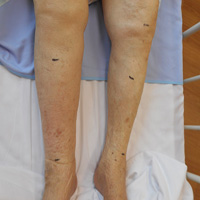Acetazolamide and SGLT2 inhibitor as potent drugs for a patient with diabetes mellitus and worsening chronic lymphedema: A case report

Accepted: 18 April 2020
HTML: 580
All claims expressed in this article are solely those of the authors and do not necessarily represent those of their affiliated organizations, or those of the publisher, the editors and the reviewers. Any product that may be evaluated in this article or claim that may be made by its manufacturer is not guaranteed or endorsed by the publisher.
Treatment of lymphedema using a pharmacologic approach is reported to have limited efficacy. Here, I report a patient with type 2 diabetes (T2DM) and acute worsening of her chronic lymphedema, in whom treatment with acetazolamide and a sodiumglucose cotransporter-2 inhibitor (SGLT2i) effectively improved the lymphedema. A 94-year-old woman, who was treated for T2DM, hyperlipidemia, and hypertension for 17 years at my hospital presented to the emergency room because of acute worsening of her chronic right leg lymphedema with increased swelling, tightness, and dull aching. A pharmacologic approach was used to treat her worsening lymphedema. Acetazolamide 500 mg/d was administered to treat the acute tissue fluid collection in the right lymphedematous leg. Ten days later, the patient’s body weight was markedly reduced by 3.2 kg, pitting in the right leg was markedly improved, and the circumference of right limb was decreased. On day 11, the glucose-lowering agent vildagliptin was switched to the SGLT2i empagliflozin 10 mg/d. On day 70, her body weight had decreased further by 2.8 kg, and the circumference of her right limb was greatly reduced compared with that under treatment with acetazolamide. Her serum chloride concentration was increased after treatment, but her hemoglobin and hematocrit values did not change during the study period. In conclusion, acetazolamide and an SGLT2i have acute diuretic effects for draining the excess tissue fluid in the lymphedematous limb without vascular contraction by enhancing vascular tonicity. Additionally, an SGLT2i may have chronic effects for reducing fat deposits in the lymphedematous limb.
PAGEPress has chosen to apply the Creative Commons Attribution NonCommercial 4.0 International License (CC BY-NC 4.0) to all manuscripts to be published.


 https://doi.org/10.4081/vl.2020.8889
https://doi.org/10.4081/vl.2020.8889




